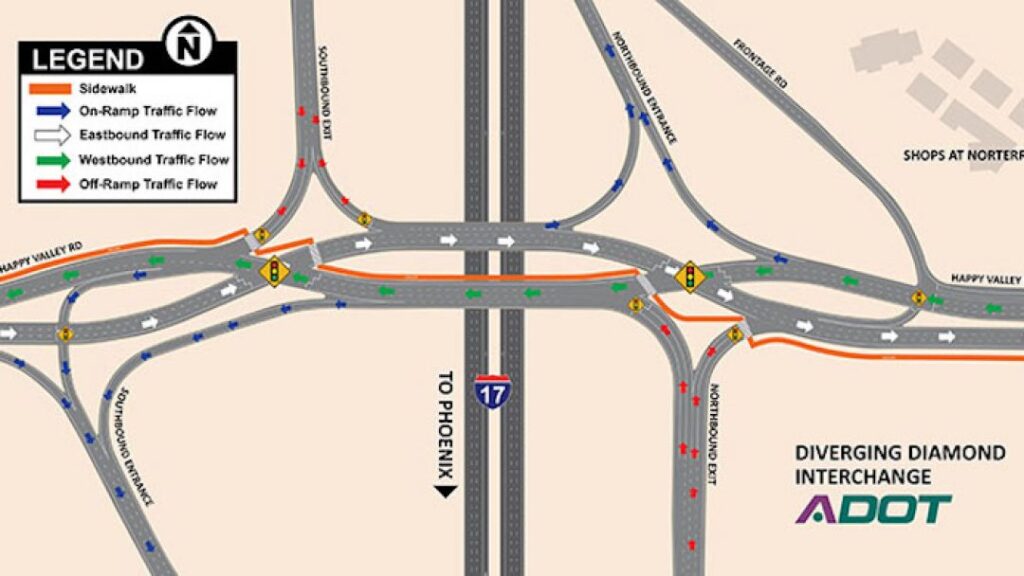Diverging What?

- Were you surprised by all the Roundabouts you have encountered in the Valley over the last few years? Well, there is a new intersection increasingly becoming common in Arizona. The Diverging Diamond Interchange. We currently have six here in Arizona
- South Mountain at Desert Foothills Parkway
- South Mountain at 17th Avenue
- The I-10/Watson Road interchange is the fourth full diverging diamond to be added along the state’s highway system.
- The nearby DDI at Miller Road opened in Aug. 2022 as part of the I-10 widening project.
- DDIs also have been constructed at I-17 and Happy Valley Road in north Phoenix
- I-10 at Houghton Road in the Tucson area.
In a Diverging Diamond Interchange, traffic on the major road (typically a highway or freeway) crosses over to the opposite side of the road before reaching the interchange. This temporary switch in lanes allows for unimpeded left turns onto ramps and improves traffic flow by eliminating the need for left-turn signal phases at the interchange. Arizona had 187 wrong-way driver deaths from 2010 to 2020. The state ranked 10th in overall deaths during that time, tied with Oklahoma.
The DDI design also includes specific lane markings, traffic signals, and signage to safely guide drivers through the interchange. The primary benefits of a Diverging Diamond Interchange are improved traffic flow, reduced congestion, enhanced safety, and more efficient left-turn movements.
While Diverging Diamond Interchanges (DDIs) have gained popularity and are generally seen as beneficial, there are some negative opinions and criticisms associated with them. Here are a few commonly mentioned concerns:
- Unfamiliarity: Since DDIs are a relatively new interchange design, some drivers may find them confusing and unfamiliar, especially if they have not encountered one before. This can lead to initial hesitation or driver error, potentially causing traffic disruptions or minor accidents until drivers become more accustomed to the design.
- Pedestrian and Cyclist Safety: Critics argue that DDIs may not provide adequate accommodations for pedestrians and cyclists. The crossing distances for pedestrians can be longer, and there may be challenges in ensuring their safety due to the complex traffic patterns and increased number of conflict points. Proper signage, crosswalks, and other safety measures are crucial to address these concerns.
- Increased Complexity and Maintenance: DDIs tend to be more complex in terms of design and construction compared to traditional interchange configurations. This complexity can result in higher construction and maintenance costs. Additionally, ongoing maintenance can be more challenging due to the unique traffic patterns and the need for specialized equipment to maintain median crossovers and signage.
- Limited Applicability: While DDIs have been successful in many locations, they may not be suitable or practical for every interchange. The specific roadway geometry, traffic volume, and land constraints can impact the feasibility of implementing a DDI. In some cases, alternative interchange designs may be more appropriate or cost-effective.
- It’s worth noting that while there are criticisms of DDIs, they are generally considered to be effective in improving traffic flow, reducing congestion, and enhancing safety. However, careful planning, clear signage, public education, and ongoing evaluation are essential to address any concerns and ensure successful implementation.
If you have driven through the new DDI interchanges in Arizona, I would encourage you to share your personal experiences and impressions.
